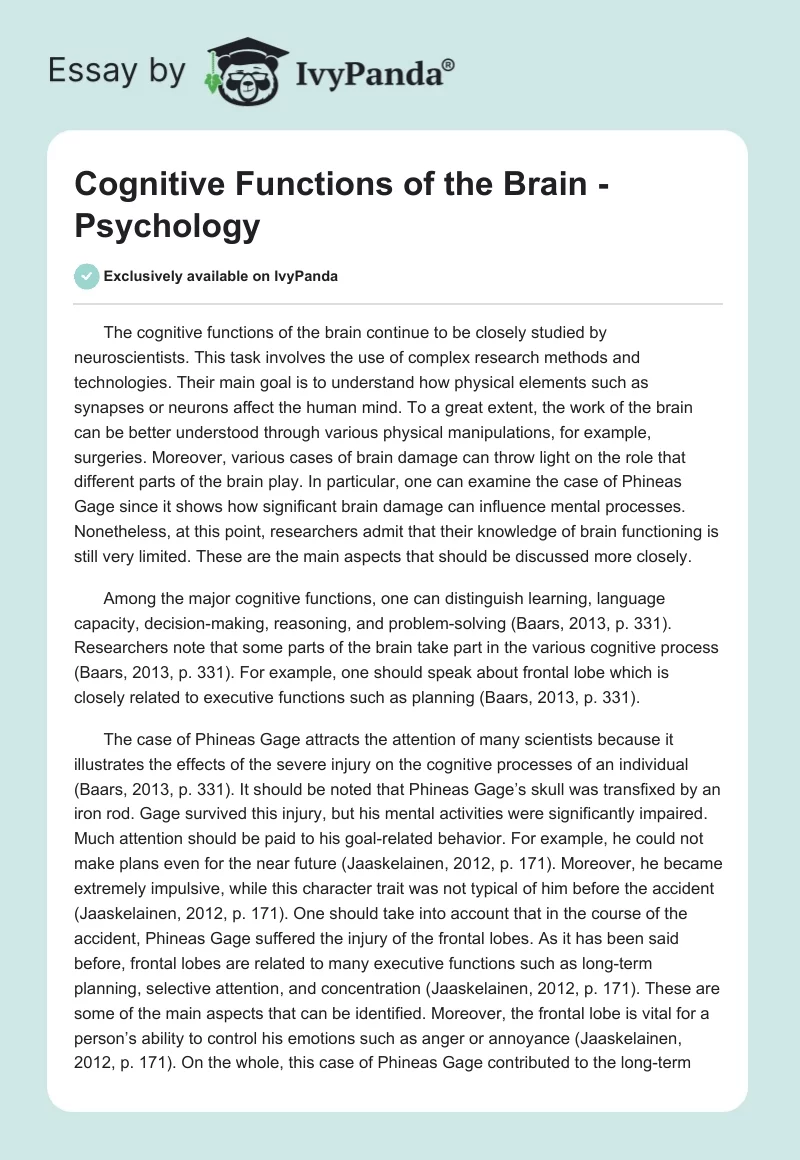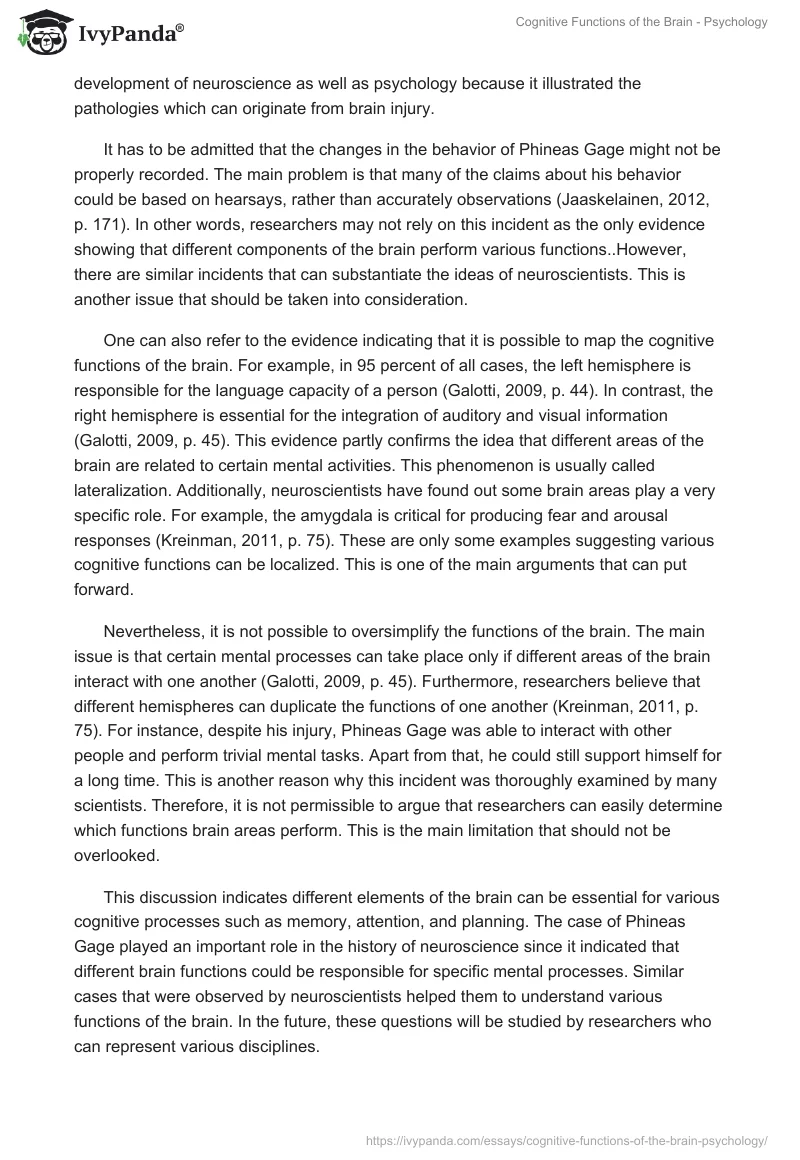The cognitive functions of the brain continue to be closely studied by neuroscientists. This task involves the use of complex research methods and technologies. Their main goal is to understand how physical elements such as synapses or neurons affect the human mind. To a great extent, the work of the brain can be better understood through various physical manipulations, for example, surgeries. Moreover, various cases of brain damage can throw light on the role that different parts of the brain play. In particular, one can examine the case of Phineas Gage since it shows how significant brain damage can influence mental processes. Nonetheless, at this point, researchers admit that their knowledge of brain functioning is still very limited. These are the main aspects that should be discussed more closely.
Among the major cognitive functions, one can distinguish learning, language capacity, decision-making, reasoning, and problem-solving (Baars, 2013, p. 331). Researchers note that some parts of the brain take part in the various cognitive process (Baars, 2013, p. 331). For example, one should speak about frontal lobe which is closely related to executive functions such as planning (Baars, 2013, p. 331).
The case of Phineas Gage attracts the attention of many scientists because it illustrates the effects of the severe injury on the cognitive processes of an individual (Baars, 2013, p. 331). It should be noted that Phineas Gage’s skull was transfixed by an iron rod. Gage survived this injury, but his mental activities were significantly impaired. Much attention should be paid to his goal-related behavior. For example, he could not make plans even for the near future (Jaaskelainen, 2012, p. 171). Moreover, he became extremely impulsive, while this character trait was not typical of him before the accident (Jaaskelainen, 2012, p. 171). One should take into account that in the course of the accident, Phineas Gage suffered the injury of the frontal lobes. As it has been said before, frontal lobes are related to many executive functions such as long-term planning, selective attention, and concentration (Jaaskelainen, 2012, p. 171). These are some of the main aspects that can be identified. Moreover, the frontal lobe is vital for a person’s ability to control his emotions such as anger or annoyance (Jaaskelainen, 2012, p. 171). On the whole, this case of Phineas Gage contributed to the long-term development of neuroscience as well as psychology because it illustrated the pathologies which can originate from brain injury.
It has to be admitted that the changes in the behavior of Phineas Gage might not be properly recorded. The main problem is that many of the claims about his behavior could be based on hearsays, rather than accurately observations (Jaaskelainen, 2012, p. 171). In other words, researchers may not rely on this incident as the only evidence showing that different components of the brain perform various functions..However, there are similar incidents that can substantiate the ideas of neuroscientists. This is another issue that should be taken into consideration.
One can also refer to the evidence indicating that it is possible to map the cognitive functions of the brain. For example, in 95 percent of all cases, the left hemisphere is responsible for the language capacity of a person (Galotti, 2009, p. 44). In contrast, the right hemisphere is essential for the integration of auditory and visual information (Galotti, 2009, p. 45). This evidence partly confirms the idea that different areas of the brain are related to certain mental activities. This phenomenon is usually called lateralization. Additionally, neuroscientists have found out some brain areas play a very specific role. For example, the amygdala is critical for producing fear and arousal responses (Kreinman, 2011, p. 75). These are only some examples suggesting various cognitive functions can be localized. This is one of the main arguments that can put forward.
Nevertheless, it is not possible to oversimplify the functions of the brain. The main issue is that certain mental processes can take place only if different areas of the brain interact with one another (Galotti, 2009, p. 45). Furthermore, researchers believe that different hemispheres can duplicate the functions of one another (Kreinman, 2011, p. 75). For instance, despite his injury, Phineas Gage was able to interact with other people and perform trivial mental tasks. Apart from that, he could still support himself for a long time. This is another reason why this incident was thoroughly examined by many scientists. Therefore, it is not permissible to argue that researchers can easily determine which functions brain areas perform. This is the main limitation that should not be overlooked.
This discussion indicates different elements of the brain can be essential for various cognitive processes such as memory, attention, and planning. The case of Phineas Gage played an important role in the history of neuroscience since it indicated that different brain functions could be responsible for specific mental processes. Similar cases that were observed by neuroscientists helped them to understand various functions of the brain. In the future, these questions will be studied by researchers who can represent various disciplines.
Reference List
Baars, B. (2013). Fundamentals of Cognitive Neuroscience: A Beginner’s Guide. New York, NY: Academic Press. Web.
Galotti, K. (2009). Cognitive Psychology: In and Out of the Laboratory. New York, NY: Cengage Learning. Web.
Jaaskelainen, I. (2012). Introduction to Cognitive Neuroscience. New York, NY: Bookboon. Web.
Kreinman, J. (2011). Foundations of Voice Studies: An Interdisciplinary Approach to Voice Production and Perception. New York, NY: John Wiley & Sons. Web.


